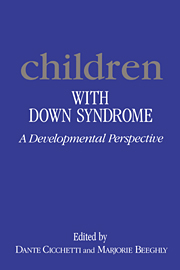Book contents
- Frontmatter
- Contents
- List of contributors
- Preface
- 1 Applying the developmental perspective to individuals with Down syndrome
- 2 An organizational approach to the study of Down syndrome: contributions to an integrative theory of development
- 3 Temperament and Down syndrome
- 4 Interactions between parents and their infants with Down syndrome
- 5 Attention, memory, and perception in infants with Down syndrome: a review and commentary
- 6 Sensorimotor development of infants with Down syndrome
- 7 The growth of self-monitoring among young children with Down syndrome
- 8 Early conceptual development of children with Down syndrome
- 9 Language abilities in children with Down syndrome: evidence for a specific syntactic delay
- 10 Beyond sensorimotor functioning: early communicative and play development of children with Down syndrome
- 11 Peer relations of children with Down syndrome
- 12 Families of children with Down syndrome: ecological contexts and characteristics
- 13 Early intervention from a developmental perspective
- Name index
- Subject index
7 - The growth of self-monitoring among young children with Down syndrome
Published online by Cambridge University Press: 02 November 2009
- Frontmatter
- Contents
- List of contributors
- Preface
- 1 Applying the developmental perspective to individuals with Down syndrome
- 2 An organizational approach to the study of Down syndrome: contributions to an integrative theory of development
- 3 Temperament and Down syndrome
- 4 Interactions between parents and their infants with Down syndrome
- 5 Attention, memory, and perception in infants with Down syndrome: a review and commentary
- 6 Sensorimotor development of infants with Down syndrome
- 7 The growth of self-monitoring among young children with Down syndrome
- 8 Early conceptual development of children with Down syndrome
- 9 Language abilities in children with Down syndrome: evidence for a specific syntactic delay
- 10 Beyond sensorimotor functioning: early communicative and play development of children with Down syndrome
- 11 Peer relations of children with Down syndrome
- 12 Families of children with Down syndrome: ecological contexts and characteristics
- 13 Early intervention from a developmental perspective
- Name index
- Subject index
Summary
Introduction
At some point during the early years, parents begin to impose limits on their child's behaviors. Restrictions are placed on where and when the child may crawl and toddle, on the objects that may be touched and explored, and the degree that caregiver and family routines may accommodate child whims. At about the same time, the child is informed about expectations for standards for conduct. Messages are given about cleanliness, respect for others and their possessions, and what constitutes acceptable behavior in one or another situation.
Despite the earnestness of parent intentions, few of their messages are initially understood by the child. Gradually, though, using gestures, declaratives, commands, affective cues, regularity, and repetition, parents make their wishes clear. In time, children start to discern the implications of requests and prohibitions, and begin to accede to their parents' demands. But more than this, children eventually internalize their parents' standards for conduct, and act upon them even when they are alone. They are able to regulate their own behavior. These achievements also suggest that a degree of predictability has become part of the child's day-to-day behavior. Increasingly, children will be asked to respond to additional standards for conduct, and to do so on their own.
This evolving scenario is not easily orchestrated. It requires parents who are responsive to, and feel a sense of responsibility for, their children. It involves children who are attentive, who try to understand, and who want to go along with parent wishes. And it demands fine tuning of parent expectations with child abilities along with the ability to adapt to unexpected situations and events.
- Type
- Chapter
- Information
- Children with Down SyndromeA Developmental Perspective, pp. 231 - 251Publisher: Cambridge University PressPrint publication year: 1990
- 9
- Cited by



